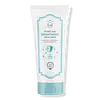What's inside
What's inside
 Key Ingredients
Key Ingredients

 Benefits
Benefits

 Concerns
Concerns

 Ingredients Side-by-side
Ingredients Side-by-side

Dimethicone
EmollientWater
Skin ConditioningDimethicone/Vinyl Dimethicone Crosspolymer
Skin ConditioningVinyl Dimethicone/Methicone Silsesquioxane Crosspolymer
Trimethylsiloxysilicate
EmollientSilica
AbrasiveGlycerin
HumectantCetyl PEG/PPG-10/1 Dimethicone
EmulsifyingIsododecane
EmollientPhenoxyethanol
PreservativeSodium Chloride
MaskingDimethicone/PEG-10/15 Crosspolymer
Magnesium Sulfate
Sodium Benzoate
MaskingDisteardimonium Hectorite
StabilisingC24-28 Alkyl Methicone
EmollientPropylene Carbonate
SolventDipropylene Glycol
HumectantSodium Citrate
BufferingTocopherol
AntioxidantDimethicone, Water, Dimethicone/Vinyl Dimethicone Crosspolymer, Vinyl Dimethicone/Methicone Silsesquioxane Crosspolymer, Trimethylsiloxysilicate, Silica, Glycerin, Cetyl PEG/PPG-10/1 Dimethicone, Isododecane, Phenoxyethanol, Sodium Chloride, Dimethicone/PEG-10/15 Crosspolymer, Magnesium Sulfate, Sodium Benzoate, Disteardimonium Hectorite, C24-28 Alkyl Methicone, Propylene Carbonate, Dipropylene Glycol, Sodium Citrate, Tocopherol
Water
Skin ConditioningDipropylene Glycol
HumectantGlycerin
HumectantCyclopentasiloxane
EmollientDimethicone
EmollientTitanium Dioxide
Cosmetic ColorantNiacinamide
SmoothingC12-15 Alkyl Benzoate
AntimicrobialMacadamia Ternifolia Seed Oil
EmollientPanthenol
Skin ConditioningBetaine
HumectantButylene Glycol
HumectantAmmonium Acryloyldimethyltaurate/Vp Copolymer
Sodium Polyacrylate
AbsorbentCetearyl Alcohol
EmollientCetearyl Olivate
Sorbitan Olivate
EmulsifyingDipropylene Glycol Dibenzoate
EmollientPPG-15 Stearyl Ether Benzoate
EmollientCetyl PEG/PPG-10/1 Dimethicone
EmulsifyingDimethiconol
EmollientTriethoxycaprylylsilane
Aluminum Hydroxide
EmollientSalvia Officinalis Leaf Extract
CleansingPrunus Serrulata Flower Extract
Skin ConditioningIllicium Verum Fruit Extract
Perfuming1,2-Hexanediol
Skin ConditioningCaprylyl Glycol
EmollientCI 17200
Cosmetic ColorantDisodium EDTA
Parfum
MaskingWater, Dipropylene Glycol, Glycerin, Cyclopentasiloxane, Dimethicone, Titanium Dioxide, Niacinamide, C12-15 Alkyl Benzoate, Macadamia Ternifolia Seed Oil, Panthenol, Betaine, Butylene Glycol, Ammonium Acryloyldimethyltaurate/Vp Copolymer, Sodium Polyacrylate, Cetearyl Alcohol, Cetearyl Olivate, Sorbitan Olivate, Dipropylene Glycol Dibenzoate, PPG-15 Stearyl Ether Benzoate, Cetyl PEG/PPG-10/1 Dimethicone, Dimethiconol, Triethoxycaprylylsilane, Aluminum Hydroxide, Salvia Officinalis Leaf Extract, Prunus Serrulata Flower Extract, Illicium Verum Fruit Extract, 1,2-Hexanediol, Caprylyl Glycol, CI 17200, Disodium EDTA, Parfum
 Reviews
Reviews

Ingredients Explained
These ingredients are found in both products.
Ingredients higher up in an ingredient list are typically present in a larger amount.
This ingredient is a high molecular weight silicone. It has emulsifying and skin conditioning properties.
Dimethicone is a type of synthetic silicone created from natural materials such as quartz.
What it does:
Dimethicone comes in different viscosities:
Depending on the viscosity, dimethicone has different properties.
Ingredients lists don't always show which type is used, so we recommend reaching out to the brand if you have questions about the viscosity.
This ingredient is unlikely to cause irritation because it does not get absorbed into skin. However, people with silicone allergies should be careful about using this ingredient.
Note: Dimethicone may contribute to pilling. This is because it is not oil or water soluble, so pilling may occur when layered with products. When mixed with heavy oils in a formula, the outcome is also quite greasy.
Learn more about DimethiconeDipropylene Glycol is a synthetically created humectant, stabilizer, and solvent.
This ingredient helps:
Dipropylene glycol is technically an alcohol, but it belongs to the glycol family (often considered part of the ‘good’ alcohols). This means it is hydrating and gentle on skin unlike drying solvent alcohols like denatured alcohol.
As a masking agent, Dipropylene Glycol can be used to cover the smell of other ingredients. However, it does not have a scent.
Studies show Dipropylene Glycol is considered safe to use in skincare.
Learn more about Dipropylene GlycolGlycerin is already naturally found in your skin. It helps moisturize and protect your skin.
A study from 2016 found glycerin to be more effective as a humectant than AHAs and hyaluronic acid.
As a humectant, it helps the skin stay hydrated by pulling moisture to your skin. The low molecular weight of glycerin allows it to pull moisture into the deeper layers of your skin.
Hydrated skin improves your skin barrier; Your skin barrier helps protect against irritants and bacteria.
Glycerin has also been found to have antimicrobial and antiviral properties. Due to these properties, glycerin is often used in wound and burn treatments.
In cosmetics, glycerin is usually derived from plants such as soybean or palm. However, it can also be sourced from animals, such as tallow or animal fat.
This ingredient is organic, colorless, odorless, and non-toxic.
Glycerin is the name for this ingredient in American English. British English uses Glycerol/Glycerine.
Learn more about GlycerinWater. It's the most common cosmetic ingredient of all. You'll usually see it at the top of ingredient lists, meaning that it makes up the largest part of the product.
So why is it so popular? Water most often acts as a solvent - this means that it helps dissolve other ingredients into the formulation.
You'll also recognize water as that liquid we all need to stay alive. If you see this, drink a glass of water. Stay hydrated!
Learn more about Water